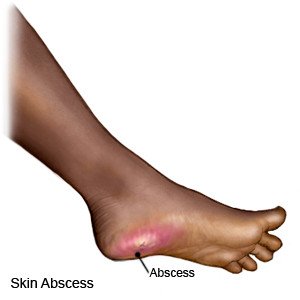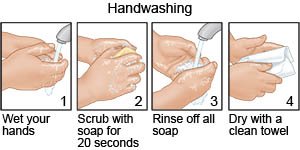Abscess
Medically reviewed by Drugs.com. Last updated on Apr 6, 2025.
What is an abscess?
An abscess is an area under the skin where pus (infected fluid) collects. An abscess is often caused by bacteria, fungi or other germs that get into an open wound. You can get an abscess anywhere on your body.
 |
What increases my risk for an abscess?
- An animal bite
- A foreign object lodged under your skin
- Heavy or frequent sweating
- A health problem, such as diabetes or obesity
- Injecting illegal drugs
What are the signs and symptoms of an abscess?
You may have a swollen mass that is red and painful. Pus may leak out of the mass. The pus will be white or yellow and may smell bad. You may have redness and pain days before the mass appears. You may have a fever and chills if the infection spreads.
How is an abscess diagnosed?
Your healthcare provider will examine the area. He or she will check to see if your abscess is draining. A sample of fluid from your abscess may show what is causing your infection.
How is an abscess treated?
- Incision and drainage is a procedure used to remove pus and fluid from the abscess. Your healthcare provider will make a cut in the abscess so it can drain. Then gauze will be put into the wound and it will be covered with a bandage.
- Surgery may be needed to remove your abscess. Your healthcare provider may do this if the abscess is on your hands or buttocks. Surgery can decrease the risk that the abscess will come back.
What can I do to care for myself?
- Apply a warm compress to your abscess. This will help it open and drain. Wet a washcloth in warm, but not hot, water. Apply the compress for 10 minutes. Repeat this 4 times each day. Do not press on an abscess or try to open it with a needle. You may push the bacteria deeper or into your blood.
- Do not share your clothes, towels, or sheets with anyone. This can spread the infection to others.
- Wash your hands often. This can help prevent the spread of germs. Use soap and water or an alcohol-based hand rub.

What can I do to care for my wound after it is drained?
- Care for your wound as directed. If your healthcare provider says it is okay, carefully remove the bandage and gauze packing. You may need to soak the gauze to get it out of your wound. Clean your wound and the area around it as directed. Dry the area and put on new, clean bandages. Change your bandages when they get wet or dirty.
- Ask your healthcare provider how to change the gauze in your wound. Keep track of how many pieces of gauze are placed inside the wound. Do not put too much packing in the wound. Do not pack the gauze too tightly in your wound.
When should I seek immediate care?
- The area around your abscess becomes very painful, warm, or has red streaks.
- You have a fever and chills.
- Your heart is beating faster than usual.
- You feel faint or confused.
When should I call my doctor?
- Your abscess gets bigger.
- Your abscess returns.
- You have questions or concerns about your condition or care.
Care Agreement
You have the right to help plan your care. Learn about your health condition and how it may be treated. Discuss treatment options with your healthcare providers to decide what care you want to receive. You always have the right to refuse treatment. The above information is an educational aid only. It is not intended as medical advice for individual conditions or treatments. Talk to your doctor, nurse or pharmacist before following any medical regimen to see if it is safe and effective for you.© Copyright Merative 2025 Information is for End User's use only and may not be sold, redistributed or otherwise used for commercial purposes.
Learn more about Abscess
Treatment options
Care guides
Further information
Always consult your healthcare provider to ensure the information displayed on this page applies to your personal circumstances.
